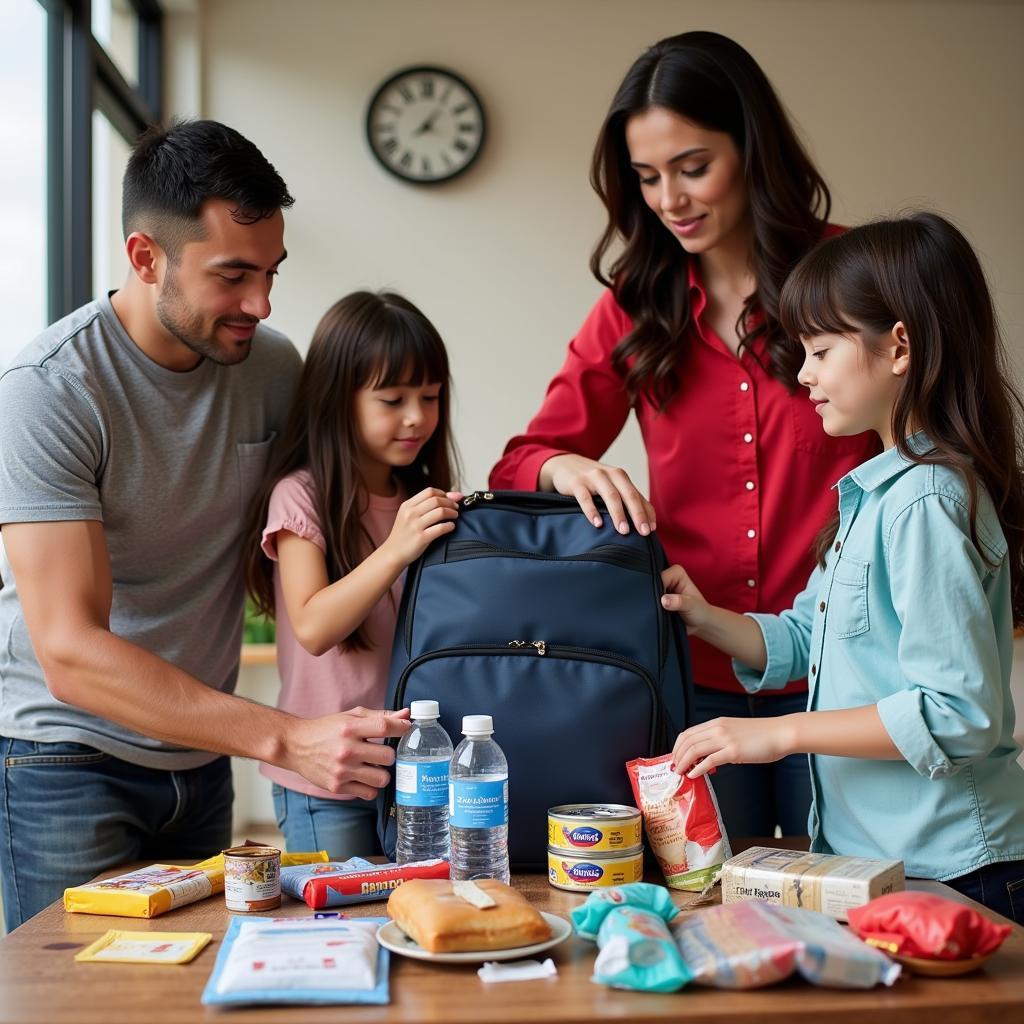When disaster strikes, having access to food and water is paramount. While we often focus on flashlights and first-aid supplies, a well-stocked disaster preparedness kit demands careful consideration of Food For Disaster Kits. This guide will provide you with a comprehensive understanding of choosing, storing, and organizing sustenance for emergencies.
 Emergency food supplies organized on a table
Emergency food supplies organized on a table
Why Food for Disaster Kits is Non-Negotiable
Emergencies can happen unexpectedly, disrupting essential services like electricity, gas, and water supply. This disruption often extends to grocery stores and restaurants, making it difficult, if not impossible, to access food. A well-stocked disaster kit ensures you and your loved ones have access to essential nutrition, reducing stress and enabling you to focus on safety and recovery.
Choosing the Right Food for Survival
Selecting food for disaster kits requires a strategic approach. You need items that are:
- Shelf-Stable: Opt for non-perishable foods that can last for an extended period without refrigeration.
- Nutritious: Choose a variety of foods that provide essential vitamins, minerals, and energy.
- Easy to Prepare: Consider foods that require minimal or no cooking, especially if access to cooking facilities is compromised.
Long-Lasting Essentials:
- Canned Goods: Canned fruits, vegetables, soups, beans, and meats offer essential nutrients and can last for years. Remember a can opener!
- Dried Foods: Dried fruits, nuts, trail mix, and jerky provide concentrated energy and nutrients with a long shelf life.
- Grains: Rice, pasta, and oatmeal are calorie-rich and can be prepared in numerous ways.
- Powdered Milk and Canned Juices: These provide essential vitamins and minerals and can supplement your water intake.
 Family preparing an emergency kit together
Family preparing an emergency kit together
Building Your Emergency Food Supply
A well-rounded emergency food supply should last a minimum of three days per person. Consider these additional factors when building your kit:
- Dietary Needs and Preferences: Accommodate any allergies, dietary restrictions, or preferences within your household.
- Special Considerations: Don’t forget baby formula, pet food, comfort foods, and any necessary medications.
- Water: Include one gallon of water per person, per day, for drinking and sanitation.
Storage and Rotation: Keeping Your Food Fresh
Proper storage is essential for maintaining the quality and safety of your survival foods and supplies.
- Cool, Dry Place: Store your emergency food in a cool, dry place, away from direct sunlight and extreme temperatures.
- Airtight Containers: Transfer food from original packaging to airtight containers to prevent spoilage and pest infestation.
- Labeling: Clearly label all containers with the contents and expiration dates.
- Regular Rotation: Practice a “first in, first out” system, rotating your emergency food supply every six to twelve months to ensure freshness.
Beyond the Basics: Additional Tips for Food Safety
- Cooking Without Power: Invest in a camping stove and fuel or a solar oven for cooking if you lose power.
- Food Safety Guidelines: Familiarize yourself with basic food safety guidelines for handling and preparing food during emergencies.
- Sanitation: Include hand sanitizer, soap, wet wipes, and garbage bags in your disaster kit for hygiene purposes.
FAQs: Answering Your Questions About Food for Disaster Kits
Q: How much food should I store in my disaster kit?
A: Aim for a minimum of a three-day supply of food per person.
Q: What are some good snacks to include for children?
A: Consider individually packaged snacks like granola bars, fruit pouches, crackers, and peanut butter.
Q: What about water? How much do I need?
A: Store one gallon of water per person, per day, for drinking and sanitation.
Q: Can I use my camping gear for cooking during an emergency?
A: Absolutely! A camping stove and fuel or a solar oven are excellent options for cooking without power.
Preparing for the Unexpected: Prioritizing Food in Disaster Preparedness
Assembling a disaster preparedness kit, with a focus on food for disaster kits, is a crucial aspect of ensuring your family’s well-being in times of crisis. By choosing the right foods, storing them properly, and staying informed about food safety, you can face emergencies with greater confidence and resilience. Remember, preparation is key. Don’t wait until disaster strikes; start building your emergency food supply today.
Need help getting started? Explore our selection of high-quality Patriot Pack food and comprehensive 3 month food survival kits designed to meet your emergency preparedness needs. For additional support, explore our resources on building a comprehensive three-month food supply.
Contact us at Phone Number: 02437655121, Email: minacones@gmail.com Or visit us at: 3PGH+8R9, ĐT70A, thôn Trung, Bắc Từ Liêm, Hà Nội, Việt Nam. We have a 24/7 customer support team.